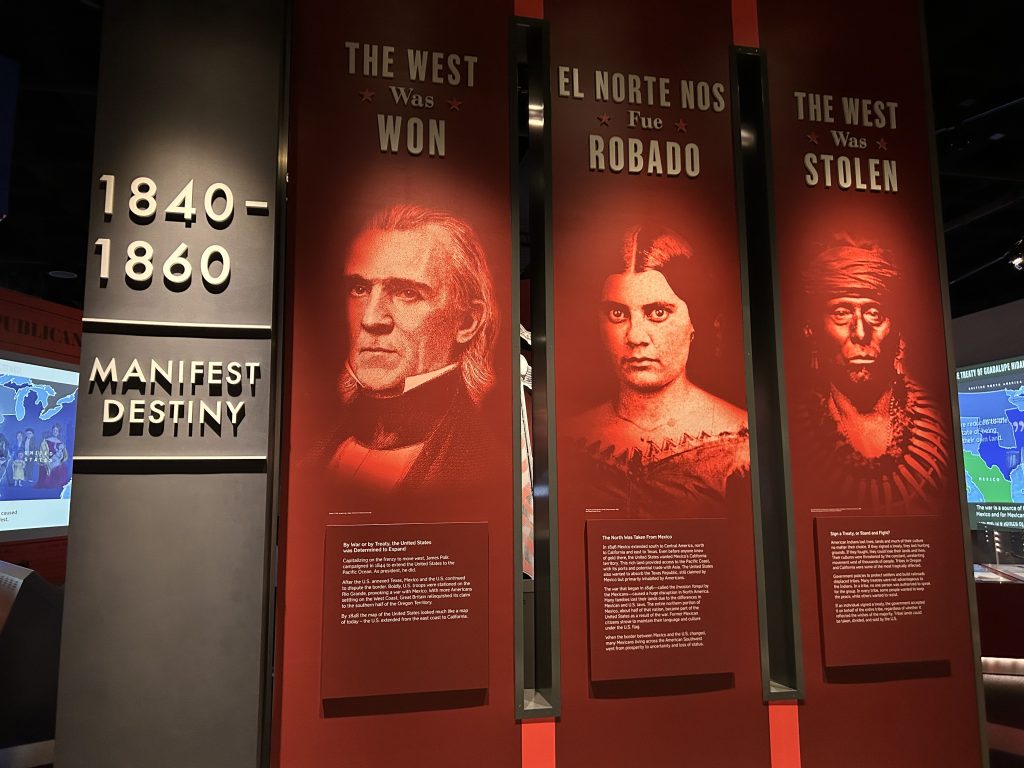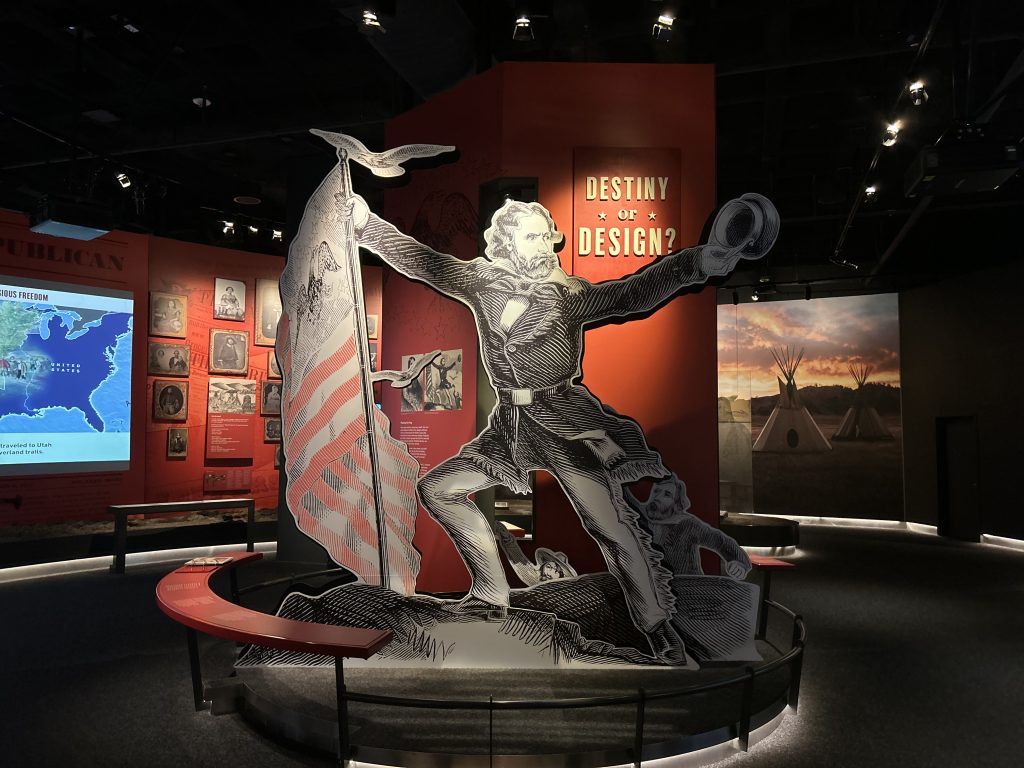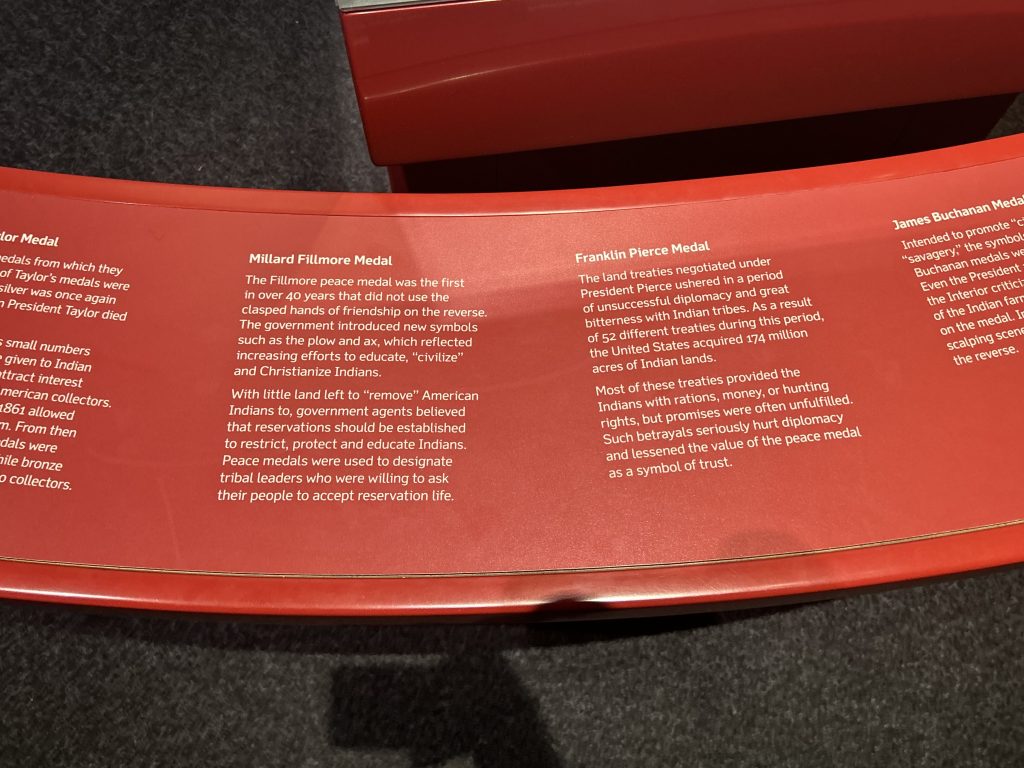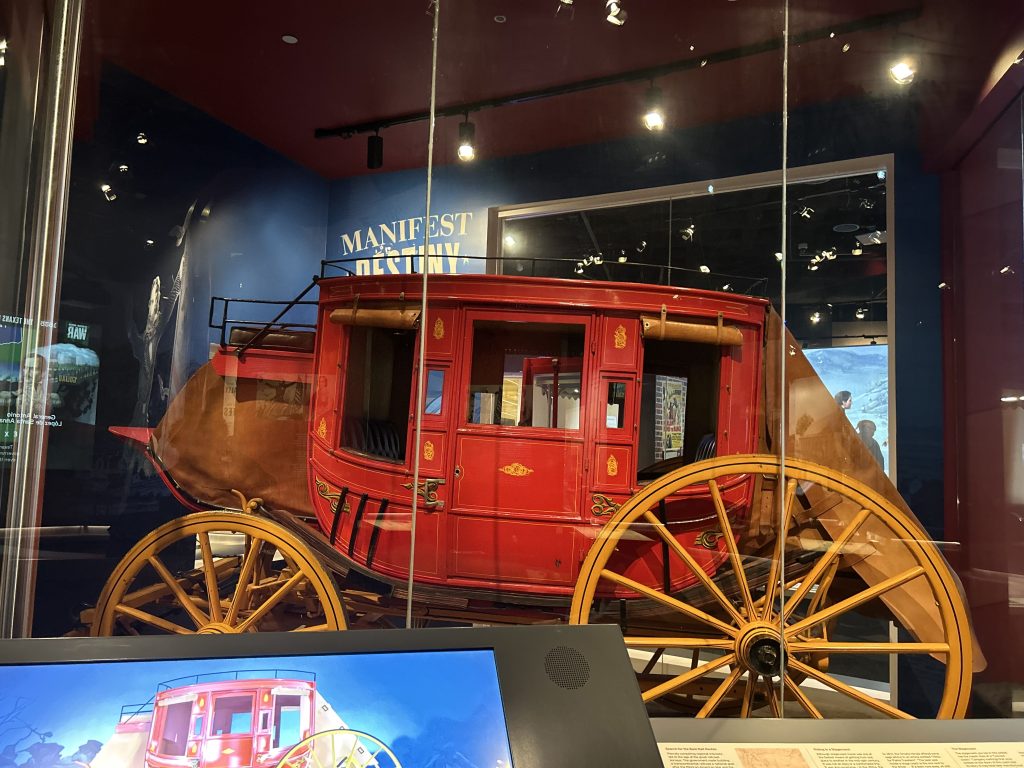Recently, I visited the Gateway Arch National Park and took the time to explore the 1840–1860 Manifest Destiny Exhibit, which seeks to “examine the conversations and conflicts among Spanish explorers, Indigenous Peoples, and American settlers during the westward expansion of the United States.” Designed to provide a nuanced understanding of Manifest Destiny—a concept that justified territorial expansion at the expense of Indigenous sovereignty—the exhibit poses the question, “Was Manifest Destiny truly destiny or design?”
The exhibit was curated by the chief curator of the Gateway Arch National Park, Jennifer Clark, although she is not credited in the exhibit itself. Interestingly, this is also the only exhibit in the museum without a clear sponsor, while others are prominently supported by various organizations.
Although the museum seeks to engage visitors through historical narratives and interactive displays, its attempt to present three differing viewpoints results in a muddled message that ultimately overlooks the implicit power dynamics and the displacement of Native People during this period.

Visitors experience the exhibit through a mix of digital and physical storytelling. A large interactive map allows users to visualize territorial changes over time, illustrating how the United States expanded westward. The exhibit’s layout is circular, with visitors engaging with the story in a non-linear way, jumping from perspective to perspective depending on which wall the visitor gravitated towards. However, there is flexibility in navigation, allowing visitors to explore topics in how they please.

Manifest Destiny shaped the territorial expansion of the United States, bringing both opportunities and conflicts among diverse groups. This framing highlights the large geopolitical shifts of the 19th century but minimizes the violent displacement of Indigenous communities. The exhibit is designed for a general audience, particularly tourists and students, with an emphasis on interactive engagement rather than deep historical critique. Some of the didactic labelling is clearly at a higher reading level. This is apparent because during my visit a mother was reading all of the labels to her 6th grader to help with homework.

While the exhibit does contribute to a broad understanding of Manifest Destiny, it adopts a largely neutral tone, often treating American expansion as an inevitable process rather than a contested historical event. This choice downplays the moral and ethical dilemmas associated with forced removals, broken treaties, and cultural erasure. A more in depth perspective would help to illuminate the overall thoughts of the Natives on the westward expansion. Something that is somewhat shown throughout the rest of the museum, but this particular portion focuses only on the initial push for Manifest Destiny.
In terms of functionality, the exhibit is well-organized, but improvements could be made. Some of the digital interactive slides would move far too quickly to read, and some of the labelling was probably hard for a younger audience to understand. A clearer flow of information would enhance comprehension, and help to streamline the visitor experience.
The exhibit employs a combination of photographs, drawings, maps, and dioramas to present its narrative. Archival documents and artifacts, such as treaty papers, weapons, and settler tools, offer tangible connections to history. However, while these elements enhance the exhibit’s visual appeal, the textual content sometimes oversimplifies complex events.
The color scheme is dominated by reds, browns, golds, and greens which somewhat related to the color of a stagecoach. The font choices are generally legible, but some informational plaques feature small text, making them difficult to read from a distance. Captions accompanying images are informative, and often if they were on a virtual screen they would be accompanied by a narrator.

One of the exhibit’s key shortcomings is its implicit bias. While it acknowledges the conflicts between settlers and Indigenous groups, it often frames these conflicts as unfortunate but necessary steps toward national growth. The term “conversations” is frequently used to describe interactions that were, in reality, violent and coercive. This choice of language subtly reinforces a settler-colonial perspective, presenting expansion as a fait accompli rather than a series of contentious and often unjust events.
A more balanced approach would involve a stronger emphasis on Indigenous agency and resistance. Incorporating more direct testimonies, primary sources from Indigenous historians, and critical perspectives on U.S. policy could provide a richer, more accurate portrayal of Manifest Destiny’s impact.

The Manifest Destiny exhibit at Gateway Arch National Park succeeds in presenting a visually compelling and interactive introduction to a pivotal era in American history. Its use of maps and artifacts effectively conveys the scale and impact of westward expansion. However, the exhibit’s reluctance to fully critique the consequences of Manifest Destiny—especially for Indigenous populations—limits its educational potential.
To improve, the exhibit should:
- Provide a bibliography or suggested readings for deeper exploration.
- Explicitly credit curators and highlight diverse scholarly perspectives.
- Expand Indigenous voices within the narrative to counteract settler-centric interpretations.
- Improve digital display functionality and text readability for accessibility.
Ultimately, the Manifest Destiny exhibit does what many history museums still struggle with, it tells a compelling story but hesitates to confront the full weight of its implications. While it captivates with visuals and interactivity, its reluctance to challenge settler-centric narratives leaves a crucial gap. Without deeper Indigenous representation and or a more critical lens, the exhibit risks turning a history of displacement and resistance into a sanitized tale of progress. It’s a step toward understanding, but not the whole journey. Overall, the exhibit is a solid educational tool but requires a more critical framework to engage with the complex legacies of American expansion.
Leave a Reply